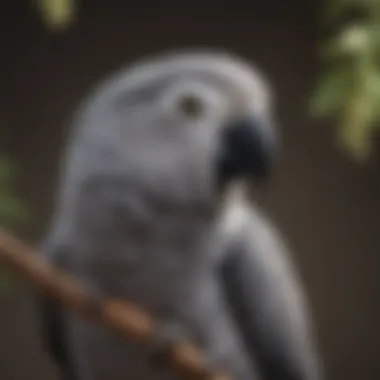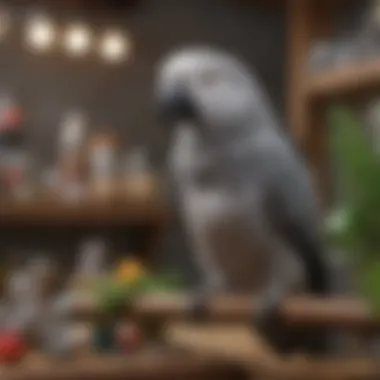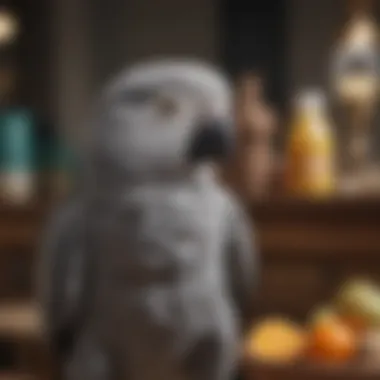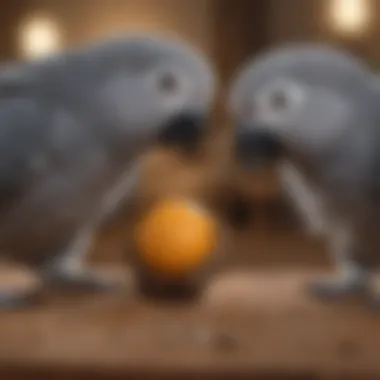Understanding the Cost of Grey Parrots: A Comprehensive Guide


Intro
Owning a grey parrot is both a rewarding and demanding undertaking. These intelligent birds necessitate not just a financial commitment, but also a commitment to their well-being. A thorough understanding of the costs associated with grey parrots can help potential owners prepare for the responsibilities they are about to take on. Some costs may be immediately apparent, such as the initial purchase price, while others, like ongoing care and veterinary expenses, are often overlooked.
Before bringing a grey parrot into your life, it’s essential to perform due diligence. This guide will explore the various aspects of financial commitment involved in adopting these remarkable companions. From initial investments to routine expenses, each of these elements contributes to the overall cost calculation of grey parrots.
The importance of informed ownership cannot be overstated. This guide aims to educate prospective owners about the multifaceted responsibilities tied to caring for grey parrots, facilitating a healthier and more respectful relationship between humans and these avian companions.
Care Tips
For a high-quality life, grey parrots need proper care routines established early on. Attention to their daily care enables them to thrive physically and mentally.
Daily Care Routines
Grey parrots typically require routines that encompass uncomplicated aspects such as feeding, cleaning, and physical interaction. Regular feeding schedules promote consistency. Therefore, plan to offer meals in the morning and evening, which enables monitoring whether your bird is eating adequately.
Cage Setup and Maintenance
Selecting the correct cage is crucial. Grey parrots are active and need adequate space. Consider a large flight cage, preferably stainless steel to improve safety and durability. Maintaining a clean environment tackles residue and waste that accumulate over time, reinforcing their health standards.
Hygiene and Cleaning Practices
Daily attention involves providing fresh water and removing old food. Weekly chores may include washing food and water dishes, as well as vacumming the area's flooring. For a thorough monthly cleaning, provide a scrub or disinfect, ensuring any surfaces or toys are sanitized accordingly.
Seasonal Care Adjustments
Consider adjustments based on the seasons. During warmer months, ensure fresh water is replaced frequently. In colder months, protect your heart feathered friend from drafts, and ensure any heating isn’t too concentrated.
Behavioral Insights
Understanding bird behavior is vital for building a friendship based relationship with grey parrots. Grasping body language and needs ensures a peaceful coexistense with your pet.
Understanding Bird Body Language
Recognize stress or irritability when feathers fluffed upward or lowered. Also, when a grey parrot leans forward, it may show sight of interest.
Common Behavioral Issues and Solutions
Behavioral pitfalls aren’t uncommon among parrots. Problems often manifest as screaming or feather plucking. These can stem from inadequate social engagement or boredom. Uncovering causes may involve offering stimulation through toys and interactions.
Positive Reinforcement Techniques
Train birds using positive reinforcement rather than negative approaches. Reward in the form of treats or praises when they exhibit sought behaviors strengthens bonds.
Social Interaction Needs
Grey parrots thrive on the company. Lack of interaction can trigger depression or behavioral changes. Allocate periodic time daily to engage with them to foster a predictable connection.
Nutrition Guides
Feeding grey parrots accurately influences health outcomes. Expert consultation may provide a thorough understanding of suitable diets for these birds.
Essential Diet Components
A comprehensive diet ico=bcommould consist of pellets, seeds, fruits, and veggies. Ensure wide-ranging colors of veggies on the shelf; this equates to a path to ensuring the system draws many vitamins.
Safe and Toxic Foods
Be cautious about certain foods. Avocado and chocolate pose dangers to their digestive systems. Consult databases for an exhaustive parrot safe food list.
Supplements and Treats
Certain vitamins and nutrient-rich powders target specific aspects of bird health. Some owners provide peanuts or other small treats; however, moderation is logic.
Feeding Strategies for Different Species
Education painted upon clarity tastes varying amongst avians. Therefore, comprehending substantial statutes can better suit diet plans properly crafted for distinctly different proclivities and habits.
Wellness and Health
Behavioural excellence ties into the health recognition. Acquiring awareness about bird wellness suits the intricate aim of bird ownership.
Routine Health Checkups
Seek avian veterinarians to schedule regular checkups annually. Schedule visits also facilitates keeping up with vaccinations, preventing potential disease outbreaks.
Identifying Symptoms of Illness


With less activity, chilled feathers, and erred feeding showing cessation to some notable signs of illness may exemplify something wrong subtly escalating.
Preventative Care and Vaccinations
Regardless be a key component to guardianship, appropriate vaccinations counterze spiral issues without clothes abound.
Mental and Emotional Well-being
Triggers premise awareness centered around establishing environments beneficial for cognitive necessities. Emotional enrichment should target regular interactions and varied activities.
Enriching Activities
Dedicating attention to enriching your grey parrot's life proliferates positive experiences. Engagement leads to happier and healthier birds.
Toys and Playtime Ideas
Consider a mix of toys to pique interest. Rotate them often to encourage interaction. Variety keeps birds mentally stimulated and reduces boredom.
Training and Tricks
Include short, simple commands as routines. Birds enjoy mental challenges, thus brief sessions may evoke enthusiastic spectrums in the surroundings.
Outdoor Activities and Interaction
Allowing outdoor time on a harness in safe conditions extends enclosure’s place. Ensure a consideration of wind flow since remains are resilient and may balance roam-safe needs.
DIY Projects for Mental Stimulation
Creating toys using paper roles, string, and boxes can lead to creative outlets for both owners and grey parrots alike. Investing time here fosters remarkable collaboration between pets and their owners.
Prelims to Grey Parrots
The opening segment of this article aims to elucidate the significance of grey parrots, both as captivating companions and the broad obligations they necessitate. Understanding these birds is critical, not only for potential owners but also for current caretakers who wish to gain a deeper comprehension of these intelligent creatures. The following sections will unpack various aspects of grey parrots, guiding readers toward responsible ownership.
Defining the Grey Parrot Species
Grey parrots are a renowned species, particularly the African Grey Parrot, known scientifically as Psittacus erithacus. Native to the rainforests of Central Africa, these birds possess remarkable cognitive abilities coupled with striking social traits. They are famous for their ability to mimic human speech, a trait that has captivated many bird enthusiasts and psychologists alike.
Two main varieties are commonly kept as pets: the Timneh grey and the Congo grey. The Timneh has a smaller stature and darker feathers, providing contrast to the Congo, which boasts larger size and striking red tail feathers. Buyers should be aware of these distinctions as they may affect personal preferences and suitability in various environments.
Categories to consider:
- Behavior: Understanding the social dynamics and articulation skills.
- Lifespan: African Greys can live upwards of 50 years, indicating a long-term commitment.
The Popularity of Grey Parrots
The tropical allure and striking appearance of grey parrots have positioned them as one of the top choices among pet birds. Many aficionados regard them not just as pets but as companions who can engage and bond emotionally with humans. Their intellectual nature demands considerable interaction, making them appealing for individuals looking for a more reciprocative pet experience.
Reasons for their popularity include:
- Speak abilites: Recognized for their uncanny mimicry, they can form impressive vocabularies.
- Intelligence: They display problem-solving capabilities and adapt quickly to routines.
In summary, grey parrots offer a mixture of emotional and intellectual engagement that draws many into their world. This article seeks to furnish readers with an understanding of the financial implications intertwined with their companionship, addressing both acquisition and care for these fascinating avian beings.
Initial Purchase Costs
Understanding the initial investment when obtaining a grey parrot is vital for potential owners. The financial commitment begins before you even bring the bird home. It's crucial to feel comfortable with the monetary obligations this ownership entails. The scope of initial purchase costs sets the stage for what follows in the pet-parent journey, highlighting its importance.
Factors Influencing the Purchase Price
Age
Age is a significant factor in determining the cost of a grey parrot. Younger birds tend to be in higher demand because many people prefer to hand-raise their pets. A baby grey parrot will often cost more than a mature one due to potential training opportunities and the desire for companionship from a young age.
Owning a young parrot can also provide advantages in terms of bond formation. However, a baby grey might need more time and care than an adult bird, which could influence your ability to provide for its needs in coming years.
Health Status
The health status of a grey parrot can greatly impact its purchase cost. Healthy birds command higher prices because they offer less risk of future veterinary bills. Understanding a bird's health records is essential as it helps predict potential health issues down the line.
When purchasing a parrot, it's advisable to inquire about its health screening and consult medical tickets. This ensures that you are investing in an animal with a lower chance of disease.
Breeding Conditions
Breeding conditions play a crucial role in bird pricing. Birds raised in optimal environments, where breeders follow korrect practices, often have better temperaments and overall health. Additionally, ethically sourced parrots will often come carriers with more detailed care guides that benefit the new owner.
On the other hand, birds bred in subpar conditions can display behavioral issues or health problems that might not be immediately obvious. This latter scenario can present future challenges and financial burdens to the new owner.
Species Variations


Different species of grey parrot can come with various price tags determined by popularity, rarity, or breeding quality. More common species like the African Grey often sell at lower prices compared to rarer species.
Variations in species can also dictate the cost of basic care items needed for different parrots. Knowing the specifics of the species variation you are interested helps in achieving an understanding of the overall ownership expense associated with it.
Reputable Breeders vs.
Pet Stores
The choice between buying from a reputable breeder and a pet store can significantly affect the purchase cost of grey parrots. Breeders often have detailed knowledge about their birds' lineage and health history. This provides assurance to potential owners about what they are acquiring. While breeders may charge a premium, the long-term benefits regarding avian well-being justify this expense.
Pet stores might initially present lower prices, but they may not always provide proper information about the parrot's health or background. This could lead to unexpected costs down the line if owners discover health issues after purchase.
Rescue Organizations and Adoption Fees
Adopting from a rescue organization often proves to be a more cost-effective approach when acquiring a grey parrot. Adoption fees from rescue centers frequently cover important starter costs like vaccinations and initial veterinary check-ups.
Furthermore, adopting supports responsible ownership, allowing prospective pet parents to take a second chance for grey parrots that need homes. However, adopters should still prepare for ongoing care expenses, since rescued birds may bring along unique management needs based on their past.
Overall, by being mindful of each factor influencing the initial purchase costs, prospective owners can make choices aligning with their financial situations while ensuring a valid and beneficial experience for themselves and their new companion.
Ongoing Care Costs
Ongoing care costs represent a significant part of the financial commitment involved in owning a grey parrot. These costs extend well beyond the initial purchase and normalize long-term budgeting. A rise in recurring expenses may surprise new bird owners, so it's crucial to comprehend the facets of ongoing care, which encompass nutrition, healthcare, and appropriate living conditions.
Nutrition and Diet Expenses
Diet is paramount to the well-being of grey parrots. Making informed choices about their food can critically influence their overall quality of life.
Commercial Bird Food
Commercial bird food plays a vital role in the nutritional plan for grey parrots. These foods are specifically formulated to meet the essential dietary needs of the bird, providing nutrients efficientl. Most formulations cater specifically to bigger avian species, enhancing acceptance and satisfaction. However, potential disadvantages can arise, such as the presence of additives that may not always be theoretically ideal. Also, sufficiency in terms of nutritional balance can vary from brand to brand.
Fresh Fruits and Vegetables
Fresh fruits and vegetables are integral in a grey parrot's diet. They offer natural vitamins and minerals, while also promoting hydration. These natural foods maintain their bird’s interest in diet, mitigating the risk of obesity due to monotonous feeding habits. However, factors like seasonality and availability can make it challenging to ensure a constant supply.
Supplements
Adding supplements to a grey parrot's diet can prevent potential nutritional deficiencies. Supplements are often enriched with specific vitamins necessary for individual health conditions. They support a bird's health when diet alone falls short. However, pet owners should be cautious regarding excessive supplementation since it might lead to toxicity.
Healthcare Costs
Healthcare plays a critical role in maintaining the integrity and longevity of grey parrots. Investing in proper health practices carries long-term benefits, impacting overall cost efficiency.
Routine Veterinary Check-ups
Routine veterinary check-ups are crucial for prevention and early detection. Regular visits to a vet can allow for up-to-date assessments of a parrot's health status. Through these check-ups, conditions can be identified typically before they become serious or expensive. Owning the indepth knowledge about common health risks lets owners stay ahead rather than tackling solutions after issues arise.
Preventive Care
Preventive care consists of maintaining good health practices. This includes administering vaccines and proactive treatment of potential ailments. Preventive measures save substantial part of predictive costs of treatment. However, preventive care might feel intricate and overwhelming for some owners, which can result in neglect without proper education.
Surgery and Emergency Care
Emergency care can quickly escalate in costs, primarily involving unexpected incidents. Injuries or sudden illnesses are factors outside the control of pet owners. Additionally, surgery costs can range widely depending on the condition and accessibility of care. While hard to predict, being financially prepared for emergencies ensures a capable response in urgent times.
Housing and Environmental Needs
A grey parrot’s environment is another crucial investment for its well-being. Correct housing tailored to their needs creates a safe haven and minimizes struggle in adaptation.
Cages and Accessories
Choosing the correct cage size and type is foundational in housing grey parrots adequatelly. Cages should provide ample room, structure, and safety for movement. Numerous accessories, including toys and perches, stimulate and entertain birds. However, the initial, one-off investment can be notable, yet the lack of appropriate premises can impede a parrot's development.
Heating and Humidity Requirements
Grey parrots, originally from rainforests, require optimized heating and humidity levels similar to their natural habitat. Proper humidity is necessary to avoid respiratory issues, while excessive temperature variations might create stress. Propper systems assisting in creating ideal clsimat can add to initial operating costs.
Enrichment Activities
Enrichment activities help maintain mental and physical health with engagement input. Various forms of play and stimulation keep a grey parrot content and help prevent behavioral problems stemming from boredom. However, ongoing costs for new activities may add in time, challenging budgeting opposed to owning a pressure-free birding experience.
Comprehensive understanding of ongoing care costs allows potential owners make neccessary financial commitments, enhancing their companionship experience with grey parrots.
Long-Term Commitment and Financial Responsibility
Owning a grey parrot represents a significant long-term commitment. Adopting one of these intelligent creatures is not merely a matter of enjoying their company or providing a home. It involves a thorough understanding of the dedication and responsibility essential for their well-being. Grey parrots can live for over 50 years, and their care must align with their complex needs.
The financial responsibility goes beyond the initial purchase. Potential owners must be prepared for ongoing costs related to nutrition, healthcare, and environmental needs. Establishing a realistic budget and preparing for the future can mitigate surprises down the line. Ignoring the long-term implications of parrot ownership can lead to challenges that detract from the joy these birds can offer.


Average Lifespan of Grey Parrots
Grey parrots have a remarkable lifespan, often reaching 50 to 60 years of age in captivity. This longevity adds to the complexity of caring for them. A commitment to a grey parrot extends well beyond a typical pet owner experience. There are several factors contributing to this extended lifespan:
- Genetic Health: Some grey parrots may have underlying health conditions that impact longevity.
- Environment: A conducive living environment ensures emotional and physical well-being.
- Diet: Balanced nutrition is essential to promote overall health.
When considering adopting a grey parrot, one should reflect on this lengthy commitment. Owners must find suitable arrangements for care if life situations change—things like aging or relocating may affect their ability to provide appropriate care.
Budgeting for Long-Term Care
Budgeting for a grey parrot requires careful planning and awareness of upcoming costs. Understanding the long-term financial implications can better prepare owners for the journey ahead. Key budget categories to consider include:
- Feeding Costs:
- Healthcare:
- Housing extras:
- Training and Socialization:
- Commercial bird food is essential, but additional fresh fruits and vegetables elevate nutritional intake.
- Monthly expenses may vary based on the type of diet you choose.
- Owners should anticipate costs for routine veterinary check-ups to maintain health.
- Emergency care may lead to unexpected expenditures, hence appropriate budgeting should include this.
- Needed accessories like toys and perches for enrichment, and appropriate cages can carry significant costs.
- Investing time and resources in training can prevent behavioral issues that may arise over time.
Budgeting for a grey parrot can sometimes feel overwhelming, but breaking it down into manageable parts fosters a clearer understanding. Expect costs to vary over a bird’s lifetime.
The effort you invest in planning and budgeting can lead to a fulfilling experience with your feathered companion.
Potential Hidden Costs
Understanding the potential hidden costs associated with owning a grey parrot is crucial for prospective owners. While many focus on the obvious expenses of purchasing the bird and its immediate care, there are several indirect costs that can accumulate over time. Ignoring these aspects can lead to financial strain and negatively impact the owner-bird relationship.
Behavioral Issues and Training Expenses
One of the significant hidden costs may stem from behavioral issues that arise in grey parrots. These intelligent creatures require mental stimulation and social interaction. Lack of proper engagement can lead to problems like excessive vocalization or destructive behavior. Training these birds to develop good habits often incurs additional expenses:
- Professional Training Sessions: Employing an avian trainer to help tackle behavioral challenges can be fruitful. Professional assistance comes with fees based on session duration.
- Training Materials: Utilizing books, DVDs, or online courses to train the bird requires investment, though beneficial for long-term outcomes.
- Time Investment: Training is not just financial; it requires the owner's dedication as well. Consider the amount of time spent on consistent training to ensure proper behavior.
Understanding the need for training and alleviating potential issues early can prove to be more cost-effective than managing behavioral challenges post-factum. Investing in early behavioral training can offset future problems, making this initial cost more of a preventive measure.
Travel and Relocation Considerations
Travel and relocation can introduce other layers of hidden costs not often discussed with pet birds. When considering any trips or moves, factors include the following:
- Care while Away: Arranging for care can mean extra financial outlay. This may entail pet sitters, boarding facilities, or friends who understand how to handle grey parrots.
- Travel Cost: Travelling with a grey parrot might necessitate special arrangements. Some forms of transport have restrictions about carrying birds, and this may result in additional fees.
- Health Certificates: Some airlines require health certifications from a veterinarian before allowing the bird to fly. Obtaining these certificates also increases the costs associated with transporting your pet.
The Value of Time and Emotional Investment
Prior to acquiring a grey parrot, prospective owners should contemplate not just the financial implications, but also the emotional and time commitments involved. Grey parrots, known for their intelligence and social behavior, require consistent attention and companionship. Understanding these factors can influence both day-to-day routines and general lifestyle choices.
Understanding Grey Parrots' Social Needs
Grey parrots are inherently social creatures. In the wild, they thrive in flocks, relying on companionship for safety and interaction. This need translates significantly in captivity. Owners must note that neglecting social interactions can result in problematic behaviors. A heightened focus on their particular needs is essential.
- Ensure sufficient interaction time. Aim for a minimum of a few hours each day.
- Provide stimulating activities to combat boredom. Toys and training sessions should be rotated regularly to keep them engaged.
- Practice positive reinforcement during training to encourage sociability and bond formation.
By recognizing these social needs, potential owners not only help foster their parrot's well-being but also stabilize their own emotional investment in the pet's health.
Impact on Lifestyle and Routine
The introduction of a grey parrot into one's life necessitates an assessment of current routines. The adjustments are substantial; therefore, the impact should not be underestimated. Here are several considerations that new owners may face:
- Daily Time Commitment: Caring for a grey parrot is not just feeding it or providing a habitat. Owners must allocate regular time for companionship and attention.
- Adaptation of Travel Plans: Trips may need careful planning to find suitable care for the pet, limiting spontaneity.
- Reduction of Calculate Free Time: Activities like reading or engaging hobbies could be more fragmented due to the attention must be given to the parrot.
The interaction with a grey parrot alters personal priorities. These changes enforce stronger emotional bonds between the caregiver and the pet. Owners neutralize any challenges associated with this new focus to enhance their daily living experiences, ultimately benefiting both parties. In essence, being mindful of time investment elevates the quality of life for both the owner and their grey parrot.
The decision to welcome a grey parrot is far-reaching, encompassing emotional fulfillment, developmental growth, and holistic lifestyle adjustment.
Culmination
The discussion of costs associated with grey parrots is critical for anyone contemplating bringing these intelligent birds into their lives. Arriving at a comprehensive understanding requires considering both immediate and chronic expenses linked to ownership.
Assessing the Total Cost of Ownership
When determining the overall cost of owning a grey parrot, several elements need inclusion. Aside from the initial purchase price, potential owners must factor in long-term food expenses, routine vet visits, and various other care necessities. Given their average lifespan of 40 years or more, comprehensive ownership analysis can prevent future financial strain.
- Initial Purchase Price: Purchase price generally ranges from a few hundred to several thousand dollars, influenced by factors like health or breeding.
- Healthcare: Consider at least an annual vet visit along with extra funding for unexpected health issues.
- Diet: Quality nutrition is not negligible and should be reflected in each budgeting plan.
By considering these factors, prospective owners can achieve a thorough understanding of the monetary commitment involved. A complete assessment will help align expectations with actual costs, leading to better decision making.
Making Informed Decisions
Making informed decisions goes beyond understanding costs such as those accounted for during the assessment of ownership. Knowledge of the time, emotional investment, and the nature of the grey parrot should influence decisions deeply.
- Commitment Level: These birds require significant attention and social interaction.
- Financial Readiness: Assess whether you have a stable financial situation for recurring costs.
- Long-Term Planning: Dual planning for potential relocations or life changes can be beneficial.
Coveting a grey from its lively presence around the house often overshadows requisite commitment. Balancing affection for the species with reality surrounding costs will serve wisely throughout the lifecycle of your feathered companion. A sought-after relationship with your new pet relies heavily on your awareness and preparedness, ensuring both your journey and that of the grey parrot is a prosperous one.















